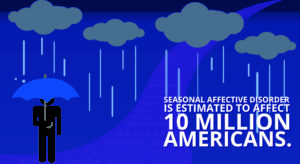NPR News: “Patients say keto diet helps with their mental illness. Science is racing to understand.”
Living with Depression: A Commercial
SAMSHA in Washington, D.C. asked me, and others, to be in this PSA about living successfully with mental illness and how important support is in recovery. I am proud of what they produced, but it’s often not easy for me to talk about living with depression. I don’t want to be defined by it. More importantly, I don’t want others to define someone else who is, likewise, struggling with a mental health problem. I hope this commercial helps.
10 Summer Depression Busters
Although my mood seems to be better with more sun, I understand why a substantial number of folks get more depressed in the summer. Extreme heat is hard to tolerate. In fact, in a study published in Science in 2013, researchers reported that as temperatures rose, the frequency of interpersonal violence increased by 4 percent, and intergroup conflicts by 14 percent.
There are four distinct types of people when it comes to weather and mood, according to a study published in Emotion in 2011.
- Summer Lovers (better mood with warmer and sunnier weather)
- Unaffected (weak associations between weather and mood)
- Summer Haters (worse mood with warmer and sunnier weather)
- Rain Haters (particularly bad mood on rainy days)
Ten percent of those diagnosed with seasonal affective disorder suffer symptoms at the brightest time of the year. The summer’s brutal heat, bright light, and long days can affect a person’s circadian rhythm and contribute to depression for the opposite reasons that winter conditions do.
If you’re a Summer Hater, or just notice that your mood is affected negatively by the heat, here are some summer depression busters that may help you better tolerate these months — maybe even enjoy them.
Emotion Rules When There is Depression
Stuck in a negative network, changing thoughts or actions is just plain hard.

“I cannot do what you suggest – I know it won’t work.”
That was Jon’s mantra as he sat in my office and said that he can never be happy. The one thing he wants – a wife and family – will never happen because fate has determined he is not going to achieve that goal. Yet most opportunities he gets to meet someone new, he believes will not work.
Why is he resisting meeting new people when someday one might be interested in him? His inability to move from one idea to another to create a change in thinking or in attitude is typical for depression. And, as in Jon’s case, it seems like it’s intentional. Or at least that’s what family and friends see when they tell their depressed loved ones to “Just do it!” It is easy to judge from the outside, but it is hard to see on the inside of a person with depression.
That stuckness is a feature of underlying neurobiology. All of us think in networks: when we start to think about a topic, we enter a network of related concepts that allows thinking to be efficient and helpful. Ideas are linked and things we need to know are easier to access when we enter a network of similar ideas, experiences, or emotions. That is why when people are trying to develop a creative solution to a problem, they brainstorm. That is, they utter or write every idea that pops into their minds about solving a problem – no matter how ridiculous it sounds on the surface – and do not assess the idea until they have a long list of options. Brainstorming is valuable because it helps us remove ourselves from the already framed network and helps create a new one.
That same efficient brain that networks and categorizes also causes a problem when depression hits. Entering a negative network that connects similar thoughts, experiences and emotions result in a depressed person linking negative networks. It promotes the discouraged outlook that is typical of depression. And, unfortunately, in depression, the ability to move to another more positive network is impaired. The weakened activity of the neurotransmitters causes “stuckness” in the pathway in the brain that allows shifting of thought and emotion.
That pathway includes a part of the brain called the anterior cingulate cortex (ACC) that should allow for rapid shifting between emotion and thinking and should aid in developing creative problem-solving. But when people suffer depression, this pathway of the brain is impaired. It may be overactive – spinning in place without creating movement. Or it may be sluggish and unable pass along cognitive decisions like, “I will try something new,” to the emotional part of the brain that generates the discouraged, “I never have good results.”
Emotion rules when there is depression. The negative “It won’t work for me,” style of thinking seems to have more power than the optimistic, “Just give it a try,” method of thinking.
Sitting with Jon, I want to say, “Just do what I am suggesting!” I want him to borrow my ability to generate a new idea, but some things have to change before he can try something new. He cannot respond to “just do it” while his negative networking is making him believe that his case is different. His notions about how to act are the ones in the network of what he has typically done, which is a very negative network.
How can he get out of this?
He needs a MAP.
When you use a map – even your navigator – you have to know where you are starting and where you are going. Jon needs to know he is currently stuck and that another way just might be possible. But where is he going? He needs to believe in a reasonable solution. In our conversations, Jon is beginning to believe that his depressed thinking is a problem.
M – (You may want to consider medication as the first M and then go to this one)
Jon needs to move. Literally, move his body. The stuck brain finds it easier to shift gears when the physical body is moving. Walking, swimming, bike riding can all be good. Try movement without earbuds pumping music. The creative brain will take over and just might jump the tracks of negativity while you move. And vigorous exercise has a way of pumping up energy that lightens depression.
A – Ask for input. When we brainstorm it works better if we have more than one person adding ideas. We spur each other into different networks. Jon might benefit if he shares his challenge of being stuck with a friend or three. And it will be good for him to ask people what gives them happiness or satisfaction. He might hear that there are many ways to be content.
P – Play around with different options. Jon does not have to commit to an idea of what is fun or pleasurable or satisfying. He would benefit from playing with the children in his life whose joy is infectious. Play sports or games. Playing stimulates different networks and may result in some changes in his mood or thoughts that may help him be less depressed.
There is a saying that life is a journey, not a destination. I do not know Jon’s ultimate destination, nor does he. The outcome of this MAP will help him find a better, more creative, and less depressed way of living his life.
By Margaret Wehrenberg, Psy.D. Margaret is the author of 5 books published by W.W. Norton, includingThe 10 Best Ever Anxiety ManagementTechniques, The 10 Best Ever Depression Management Techniques and her most recent 10 Best Anxiety Busters, an ideal book for the general public. She earned her M.A. studying psychodrama and bioenergetics, and had years of experience as a certified drug and alcoholism counselor, before earning her Psy.D. She now specializes in treating anxiety and depression and has a private practice in Naperville, IL. She is a frequent contributor of articles to The Psychotherapy Networker magazine, has contributed a chapter to Clinical Pearls of Wisdom (Ed. M. Kerman), and has produced CD for breathing, muscle relaxation and imagery for anxiety management.
This article originally appeared in Psychology Today magazine.
Don’t Let Burnout Get the Best of You
Burnout often results from extended periods enduring the emotional stress precipitated by unaccomplished expectations or failure to fulfill unreasonable demands. The symptoms can include intensified emotional exhaustion, physical fatigue, lowered self-worth, changes in eating and exercising habits, social withdrawal, sleep disorders, anxiety, and depression.
There are specific and reproducible patterns of changing neural activity and brain connectivity associated with the stress buildup that leads to burnout. In the high-stress state subjects’ neuroimaging scans reveal less activity in the higher, reflective brain (Prefrontal cortex/PFC) and more activity in the lower, reactive brain that controls involuntary behaviors and emotional responses.
Prolonged stress correlates with structural increases in the density and speed of the neuron-to-neuron connections in the emotion-driven reactive networks of the lower brain and corresponding decreases connections in prefrontal cortex conscious and reflective control centers.
The explanation of these changes is attributed to the brain’s neuroplasticity defined by the phrase: “neurons that fire together, wire together.” The brain literally rewires to be more efficient in conducting information through the circuits that are most frequently activated.
When stress is frequent, the more frequent activation of the neural pathways to the lower, stress-reactive brain results in their strengthening from enhanced wiring (dendrites, synapses, myelinated axons). These pathways can become so strong that they become your brain’s fast route to its lower, reactive control centers. The stressful, burned out state when the lower, reactive brain is in charge overcomes the calm, reflective, and productive higher neural processing in the (PFC) – the preferred brain locale for control of behavior and emotional self-management.
As your efforts to achieve unreasonable goals are thwarted or increasing demands recur, and the lower brain dominates more frequently, you lose touch with your reflective brain. With less management coming from your reflective PFC, it becomes harder and harder to logically see these challenges in realistic perspective or to solve problems creatively.
Disappointments take on more emotional power and without your higher brain’s perspective, they are interpreted as personal failures. Your self-doubt and stress further activate and strengthen your brain’s involuntary, reactive neural networks. The spiral down to burnout accelerates as these circuits become the automatic go-to networks. Your brain achieves less success in problem-solving and emotional control and ultimately reacts by withholding efforts to escape the burnout state.
Reset Your Brain’s Default Neural Network from Retreat to IGNITE!
The good news is you can apply what we’ve learned from neuroscience about your brain’s survival mode to take actions to retrieve voluntary control of your choices and emotional wellbeing.
You can activate the same neuroplasticity, that gave dominance to the lower brain networks in the burnout state, to construct a new, stronger positive default response. With increasing successful experiences in achieving goals, you can reset the circuits to redirect your brain to access its highest cognitive resources. You can build up newly improved circuitry switching your responses from retreat to IGNITE for mindful awareness and creative problem-solving!
Since an effort-failure pattern sets up the brain’s survival response to withhold effort, you’ll need to strengthen your brain’s recognition that effort toward your goals can result in success. Your weapon of mass reconstruction can come from your brain’s very powerful drive for its own intrinsic neurochemical reward— dopamine and the deeply satisfying and motivating pleasure it brings. When the brain releases dopamine in rewarding bursts, you experience a deep intrinsic satisfaction along with increased motivation, curiosity, perseverance, and memory. Dopamine is particularly released when your brain recognizes that you’ve achieved a challenge (from the “I get it” of figuring out a joke to the satisfaction of completing a marathon).
To get the dopamine-pleasure response from challenges achieved, you’ll need to plan for your brain to experience frequent recognition (feedback awareness) of incremental progress. The choices of what you set as a goal should be guided by their desirability and the goal’s suitability to be broken down into clear segments. You want to set goals, the progress of which, you can chart or easily recognize with each stepwise challenge and success. The pleasure burst of dopamine’s intrinsic motivation accompanying your brain’s recognition of each progressive increment achieved in the goal pathway will keep you motivated to persevere.
Goal Buy-In for Your Brain’s Neural REWIRING
Buy-in and relevance are important in choosing your rewiring goal. Since your goal is to rewire your brain’s expectations that your goal efforts do yield progress, despite increasing challenge, you need to really want the goal. This is not the time to challenge yourself with something you feel you should do, but won’t really look forward to, such as dieting, climbing stadium stairs, or flossing after every meal.
The idea of planning and achieving goals as a burnout intervention is probably not new to you. These are likely to be activities you’ve considered but didn’t do for the obvious reason. They take time. when it comes to adding another activity to your schedule, past experiences have left you with the expectation that there is not enough time.
These first goals that can provide ongoing awareness of your progress are often tangible (visible, such as planting a garden or making pottery on a wheel, or auditory such as playing an instrument, or physical such as learning tai chi), but your goal can also be spending more time on something you already do, but want to do more frequently or successfully, such as journaling, practicing yoga, or sketching.
You’ll Find Your Own Goal for Buy-In, but Here are Some Examples of Planning
Physical goals: Notice I didn’t say exercise. That’s not as motivating as “training” for a physical goal you want to achieve, even though they often overlap. If you want to run a 10K, and you enjoy running, the goal for an achievable challenge could first be building up to the distance starting with your baseline distance you comfortably run now. Then, plot out the increments that you’ll consider progressive successes, such as adding 100M each day or a week (with increments based on what you consider both challenging and achievable). Once you reach 10K goal, speed can become the next goal again plotted out in segments of incremental progress before you start.
Hobbies: From woodworking to shooting wooden arrows, hobbies really are opportunities for brain rewiring. Again, plan your stepwise achievable challenge increments. If you select darts, start with a home dartboard—low initial investment and throw from a close, but challenging distance at first. As you get better in accuracy move back further. Record your results with the notations of the distance of each improvement you set as an achievable challenge. If you get so good that you are no longer challenged by the dartboard, try that archery!
Mindfulness and meditation are certainly positive interventions for burnout and will be topics of a subsequent blog.
Your Rewired Brain’s Default Changes from Defeat to Ignite
With your understanding of what happened in your brain to create the hopeless frustration of burnout, you’ll hopefully have more positive expectations to help you put in the effort to try (or retry) suggested interventions. Your own natural dopamine-reward system will then be at work deconstructing the resistance network built by your burnout as you reset your circuits of motivation.
The repeated experiences of dopamine-reward you’ll experience as you monitor your goal progress will literally change your brain’s circuitry. Repeated effort-reward experiences promote the neuroplasticity creating neural networks that expect positive outcomes in your new default network. This is because your brain will build stronger connections into the memory pattern. The expectation in achieving this challenge will bring pleasure. As with other less used networks, the previous lower brain stress-activated go-to response network you developed in burn-out, that caused you to react negatively to stressors, will be pruned away from disuse.
You’ll be rewired with optimism and renew positive expectations about your self-efficacy. With your higher, reflective brain back in control, as you access your perseverance, innovation, and creative problem-solving when you need them.
Just be sure to take the time to break down big challenges into opportunities to recognize incremental progress as you achieve each small step en route to your goals. With that positive recharge, your well-deserved dopamine reward will sustain your brain’s motivated perseverance on to the next step of the path to your goals.
By Judy Willis, M.D., M.E
Dr. Willis is a board-certified neurologist and middle school teacher, specializing in brain research regarding learning and the brain. After graduating Phi Beta Kappa as the first woman graduate from Williams College, Willis attended UCLA School of Medicine where she was awarded her medical degree. She remained at UCLA and completed a medical residency and neurology residency, including chief residency. She practiced neurology for 15 years before returning to university to obtain her teaching credential and master’s of education from the University of California, Santa Barbara. She then taught in elementary and middle school for 10 years and currently is on the adjunct faculty of the Graduate School of Education, University of California, Santa Barbara.
This article first appeared in Psychology Today magazine
Seasonal Affective Disorder: What You Need to Know
 We set our clocks back an hour in early November, resulting in shorter days, and darker skies before most of us leave work each afternoon.
We set our clocks back an hour in early November, resulting in shorter days, and darker skies before most of us leave work each afternoon.
It is important to understand the effect that light has on us. If you find yourself falling into the doldrums at this time of year as the number of daylight hours dwindle, seasonal affective disorder (SAD), sometimes called seasonal depression, may be to blame. Most SAD sufferers experience symptoms during the winter months, causing researchers to conclude that inadequate sunlight may play a role. But you don’t have to spend the winter months feeling depressed and unmotivated. Here’s what you need to know about SAD and how to alleviate it.
What Causes Seasonal Affective Disorder?
Most researchers believe decreased access to sunlight plays a role in seasonal affective disorder. Light affects our circadian rhythms, and UV rays can also change how the body processes vital minerals and other nutrients. For example, inadequate sunlight exposure is linked to low Vitamin D, which, in turn, has been linked to depression and other physical and mental health woes. So, the effects of darkness on the body—not just darkness itself—might be partially to blame.
A recent study, published in the Journal of Affective Disorders, bolstered the connection between SAD and inadequate sunlight. It found that weather and climate—including rain and pollution levels—don’t appear to alter mood. But access to sunlight is a major predictor of mental health. In the study, people who lived in regions with shorter, darker days were more likely to experience poor mental health.
While light almost certainly plays a role, not all cases of SAD occur during the short, dark days of winter. A small fraction of cases occur on a seasonal basis during the spring or summer, which suggests that no single factor can fully explain SAD. Other potential risk factors include:
- Seasonal lifestyle changes. If you only work during a portion of the year, have less to do during a specific time period, or face annual stress, you may experience seasonal depression.
- Seasonal associations with previous trauma and grief. Our minds form strong connections between the sights and sounds of seasonal shifts and memories of the past. You may find yourself growing depressed each year around the time you suffered a trauma or loss.
- Cultural norms and traditions. The high of the holiday season followed by the low of the new year can spur depression in some people.
- Certain health issues are more likely to manifest at specific times of the year. For example, if you have severe allergies, you may get depressed in the spring, while chronic bronchitis can make the winter months depressing.
Each of these factors alone is unlikely to trigger depression, but in conjunction with other risk factors—including a family history of any form of mental illness—they can lead to SAD.
Symptoms of Seasonal Affective Disorder
Cyclical depression that occurs around the same time each year or that relents when the season changes, is the hallmark of SAD. If symptoms are not cyclical, you might be diagnosed with another disorder, such as major depressive disorder or dysthymia.
People with SAD often experience depressive symptoms which are less severe than those associated with major depressive disorders. Though suicidal thoughts can and do occur—particularly if SAD is left untreated—these thoughts are less common. Some common symptoms include:
- Low energy, feelings of grogginess, or excessive sleep. People with summer SAD may experience insomnia.
- Changes in appetite. People with SAD are vulnerable to weight gain. SAD sometimes causes carbohydrate cravings, because carbs offer a temporary energy boost.
- Irritability and anger.
- Changes in your relationships with others: People with SAD often feel lonely and rejected.
- Loss of interest in previously enjoyed activities.
- Feelings of guilt.
- Dread or uncertainty about the future.
- Loss of motivation.
- Feelings of sadness.
Treatment for Seasonal Affective Disorder
People with winter SAD often respond well to light therapy, which involves sitting under a UV lamp for a short period of time each day. If you have access to daylight and can spend time outdoors, you might also find your symptoms improving if you receive 20-40 minutes of daily direct sun each day.
Treatment for major depression can also prove effective at treating SAD. Those treatment options include:
- Psychotherapy to help you talk through your feelings, identify problematic thought patterns, and more effectively cope with your depression. If causes relationship problems, therapy may also help improve your relationships. Your therapist can also talk to you about lifestyle changes—diet, exercise, activities—that may complement your treatment and help to alleviate your depression.
- Antidepressants: Depression alters chemicals in your brain. Sometimes lifestyle remedies are inadequate to get things back on track. Antidepressants can be effective and often need only to be taken for a short period.
Is It Possible to Prevent Seasonal Affective Disorder?
Research on the prevention of SAD is mixed. However, there is some evidence that light therapy can help prevent SAD in people with a previous history of the condition. If you’re worried that you might develop SAD this winter, talk to your doctor about preventative strategies. Also, maintain a healthy lifestyle—overeating during the holidays, excessive spending, and low motivation can all make SAD worse.
If you experience SAD, you don’t have to suffer through months of misery. SAD is one of the most treatable forms of depression, and with the right care, you can feel better in weeks, or even days.
This article originally appeared in Psychology Today magazine
Joel L. Young, M.D., is the Medical Director of the Rochester Center for Behavioral Medicine outside of Detroit and teaches Psychiatry at Wayne State University School of Medicine. Trained at the University of Michigan, Dr. Young is certified by the American Board of Psychiatry and Neurology and holds added qualifications in geriatric and forensic psychiatry. In addition, he is a diplomate of the American Board of Adolescent Psychiatry.
Dr. Young and his clinic have been primary investigators in a number of clinical trials involving antidepressant, AD/HD, and bipolar medications. He has authored three books and more than 70 textbooks and articles. His most recent book, When Your Adult Child Breaks Your Heart: Coping with Mental Illness, Substance Abuse, and the Problems That Tear Families Apart, was published by Lyons Press in December 2013.
References
- Seasonal affective disorder (SAD). (n.d.). Retrieved from http://www.mayoclinic.org/diseases-conditions/seasonal-affective-disorde…
- Sunshine matters a lot to mental health; temperature, pollution, rain not so much. (n.d.). Retrieved from https://www.eurekalert.org/pub_releases/2016-11/byu-sma110316.php
The Role of Anger in Depression
Sigmund Freud used to refer to depression as anger turned inward. While many people may regard this as an overly simplistic approach to the most common mental health disorder in the world, there is no doubt that anger plays a significant role in depression. As one study from 2016 found, when it comes to emotional disorders in general, the presence of anger has “negative consequences, including greater symptom severity and worse treatment response.” Researchers concluded that “based on this evidence, anger appears to be an important and understudied emotion in the development, maintenance, and treatment of emotional disorders.” When it comes specifically to depression, science seems to be further supporting Freud’s theory, showing more and more how anger contributes to symptoms. A UK study from 2013 suggested that going inward and turning our anger on ourselves contributes to the severity of depression.
Having worked with depressed clients for more than 30 years, these findings were not surprising to me. Many of the people I’ve worked with who struggle with depression also share the common struggle of turning their anger on themselves. As much as I try to help my clients express their anger rather than take it on and turn it inward, I witness first-hand how hard it often is for people to interrupt this process. It’s a challenge for them to recognize the nasty way they treat themselves; they are significantly more critical of themselves that they are of others.
People who suffer from depression often have intense “critical inner voices” that perpetuate feelings of unworthiness and shame. When they listen to this inner critic, they not only feel more depressed, but they also find it much more difficult to stand up to their depression. This includes acting against their critical inner voices, taking positive actions that could help them feel better about themselves (like engaging in activities they enjoy), and being more social.
Getting angry at these “voices” can be liberating, but that means getting in touch with our core feelings of anger rather than aiming it at ourselves. Dr. Les Greenberg, the founder of Emotionally Focused Therapy, describes an important difference between adaptive anger and nonadaptive anger. Anger is an adaptive response when it motivates you to assertive action to end a violation. For example, when we may feel angry at the cruel way we treat ourselves today, we’re in touch with our adaptive anger, and we feel like we’re on our own side. Letting ourselves feel and express adaptive anger can help us feel less burdened, freer, and more in touch with our real self.
Maladaptive anger, on the other hand, affects us negatively. For one thing, it can contribute to feeling victimized, sulky, or stuck in a feeling of being wronged. Examples of maladaptive anger turned inward can include feeling overly critical toward ourselves, hating ourselves, or seeing ourselves as powerless, pathetic, or helpless. The generally dysfunctional responses that result from maladaptive anger are based on emotional schema from traumatic experiences in our past. Often, our critical inner voice is at the root of maladaptive anger, driving us to remain in a state of frustration and suffering.
We can almost feel the difference between maladaptive anger dragging us down and deeper into a state of anxiety or depression and adaptive anger relieving us of a heavy burden, lightening us emotionally, and contributing to our taking constructive actions. While it can feel scary to face these deeper, core emotions, we must access adaptive emotions to transform our maladaptive emotions. This can be a vital process in helping us deal with depression.
One study by Dr. Greenberg showed that Emotionally Focused Therapy can transform maladaptive emotion through the process of expressing it and eliciting the response of an adaptive emotion, i.e. adaptive anger. This approach was especially effective in improving depressive symptoms, interpersonal distress, and self-esteem. As Dr. Greenberg described it, the process “aims within an affectively attuned empathic relationship to access and transform habitual maladaptive emotional schematic memories [articulated as critical inner voices] that are seen as the source of the depression.” Transforming these maladaptive emotions may, therefore, be one of the keys to fighting depression.
Our approach to transforming anger turned inward, which has some similarities to Greenberg’s approach, is to have the person verbalize their critical inner voices as though someone else was telling them these angry thoughts. We also encourage the person to express the feeling behind the thoughts. Often, when people do this, they express a lot of rage toward self. By saying the thoughts in the second person (as “you” statements), they begin to get some separation from their harsh, critical attitudes, and often have insights about where these thoughts come from. It sets the stage for them “answering back” to these attacks and taking their own side. The goal is also to help the person develop more self-compassion and a kinder, more realistic point of view toward themselves.
As we externalize our negative thoughts and the accompanying anger, we can better stand up to our inner critic and take a compassionate stance toward ourselves, treating ourselves as we would treat a friend. This doesn’t mean denying our struggles and setbacks, but it does mean embracing the practice of self-compassion. Self-compassion, as defined by researcher Kristin Neff, involves three key elements: self-kindness, mindfulness, and awareness of common humanity. Research has shown that the practice of self-compassion can significantly reduce a depressed mood. As one study pointed out, maladaptive or irrational beliefs underlie the development of depression, however, when high levels of self-compassion helped to counteract these negative thoughts, there was no longer a significant relationship between irrational beliefs and depression. This same study showed that it is “especially the self-kindness component of self-compassion that moderated the irrational belief-depression relationship.” Thus, the primary aim for someone struggling with resolving their emotions around depression is to treat themselves and regard their feelings the way they would a friend. It’s not about feeling sorry for ourselves, but about feeling strong and worthy and less afraid to make mistakes.
Ultimately, accepting that anger plays a role in our depression should be an empowering tool in our fight to feel better. When people express anger outwards in a healthy adaptive manner, they feel less depressed. Accessing and expressing this anger isn’t a matter of acting out, being explosive, or feeling bitter toward our surroundings. In fact, it means exactly the opposite. It’s an act of standing up for ourselves and accepting that we are not who our “voices” are telling us we are. It’s a process of facing up to the things that hurt us but also facing off against the inner enemy we all possess that drives us deeper into our suffering. The more we can take our own side and resist our tendency to turn our anger on ourselves, the more compassionate and alive we can feel in facing any challenge, including depression.
Lisa Firestone, Ph.D., is a clinical psychologist, author, and the Director of Research and Education for the Glendon Association. She studies suicide and violence as well as couples and family relations. Firestone is the co-author (with Robert Firestone and Joyce Catlett) of Conquer Your Critical Inner Voice, Creating a Life of Meaning and Compassion, and Sex and Love in Intimate Relationships. Firestone speaks frequently at conferences including the APA, the International Association of Forensic Psychology, International Association of Suicide Prevention, the Department of Defense and many others. She has also appeared in more than 300 radio, TV, and print interviews including the BBC, CBC, NPR, the Los Angeles Times, Psychology Today, Men’s Health and O Magazine.
Some Law Schools Take The Lead in Students’ Well-Being, Report Finds
The National Task Force on Lawyer Well-Being said in a report released earlier this week that law schools must change their cultures so that everyone—professors, administrators, and students—takes responsibility for student well-being. The report, issued by a coalition of groups including the American Bar Association and the Association of Professional Responsibility Lawyers, stems from a groundbreaking study published last year showing that more than 40 percent of students felt they needed mental-health help and a quarter were at risk for problem drinking. Read the rest of the story here.
Getting Some Shut-Eye With Anxiety and Depression
From The New Yorker Magazine, a great set of illustration and wonderfully capture the world of living with depression and anxiety. Read the article.
Yoga Can Help Treat Depression, Studies Show
Built by Staple Creative
















